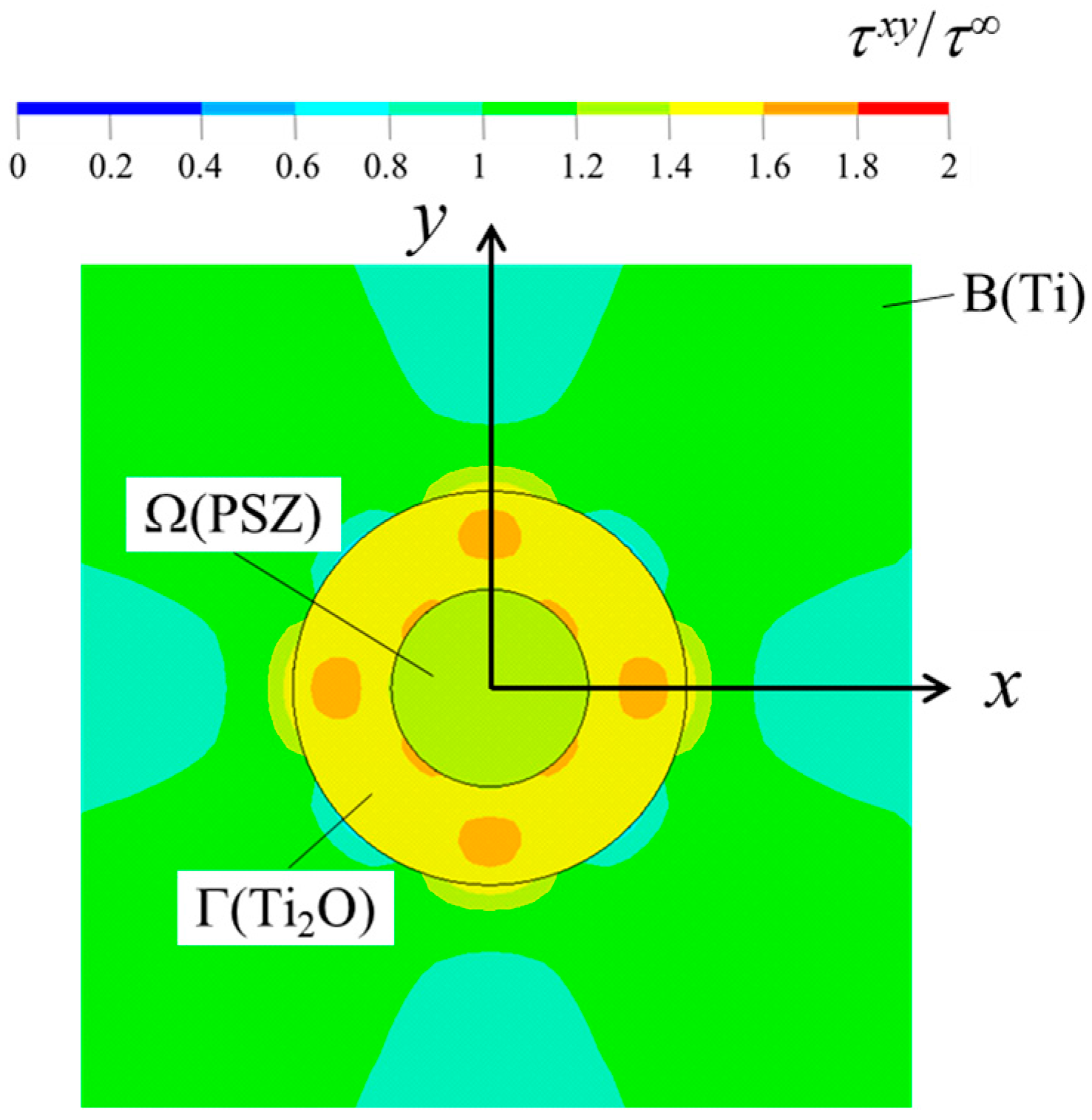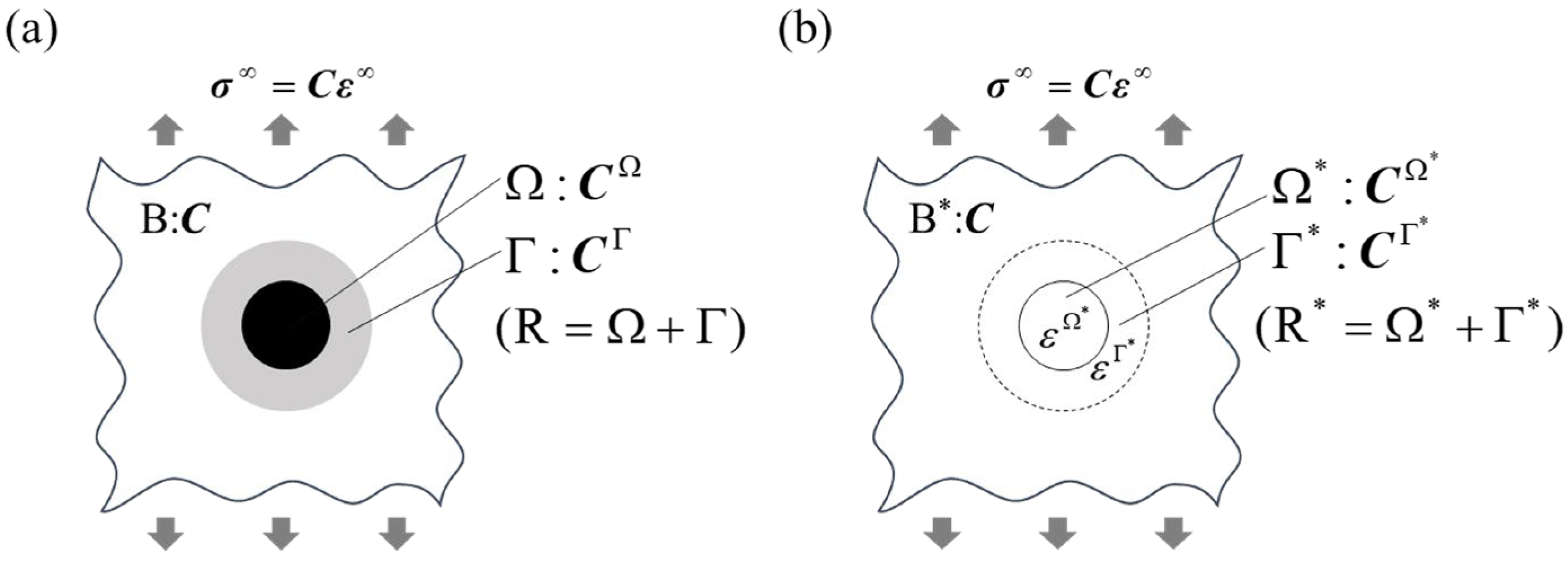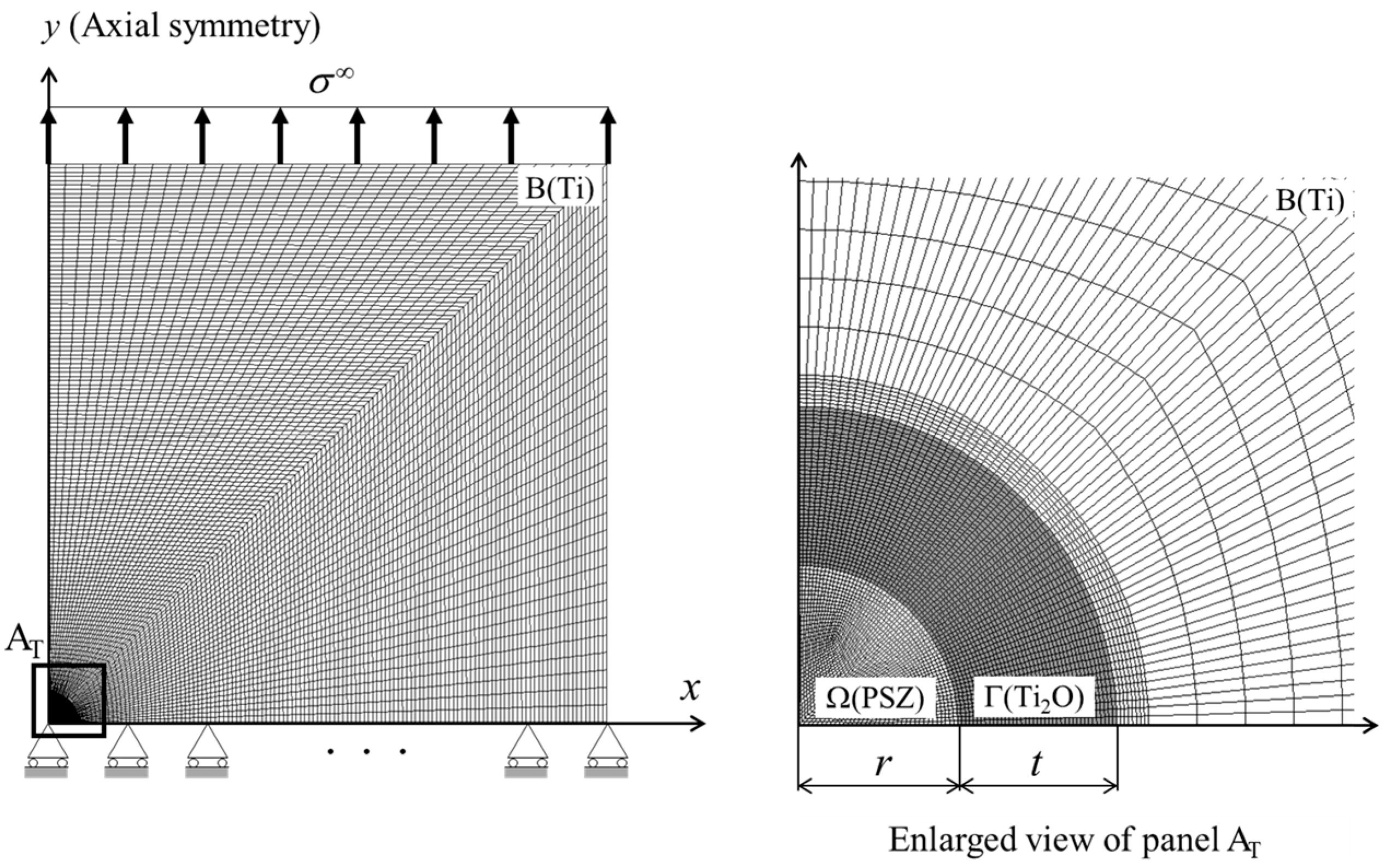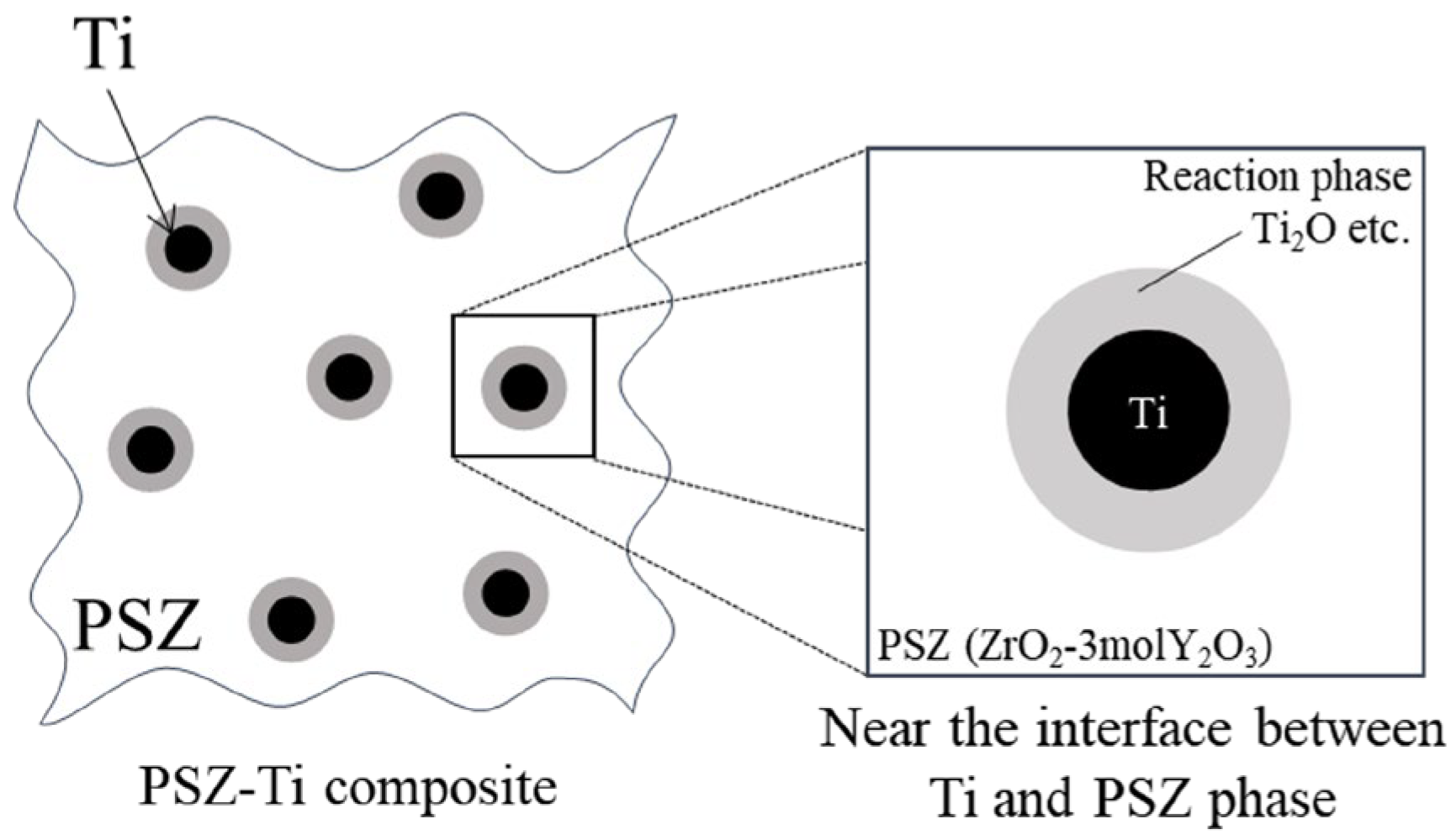Micromechanical Approach to Predict Mechanical Properties of Particulate-Dispersed Composites with Dissimilar Interfacial Phases
Abstract
1. Introduction
2. Double-Inclusion Model and Its Accuracy
2.1. Double-Inclusion Model
2.2. Validation of Double-Inclusion Model
2.2.1. Finite Element Analysis
2.2.2. Results and Discussion for Assessing Validity of Double-Inclusion Model
3. Mechanical Evaluation of Three-Phase Composites
3.1. Modeling of Three-Phase Composite Based on Double-Inclusion Model
3.2. Application of Double-Inclusion Model for PSZ-Ti Composites
3.2.1. Elastic Properties of PSZ-Ti Composites
3.2.2. Elastic-Plastic Properties of PSZ-Ti Composites
4. Conclusions
- The double-inclusion model can accurately predict the macroscopic stress state in the composites. However, it is not possible for the double-inclusion model to accurately calculate the microscopic stress of each phase simultaneously.
- The micromechanical approach was formulated. The approach can predict the elastic-plastic behavior of a composite in which reinforcements surrounded by dissimilar materials are placed in a matrix.
- The micromechanical approach was applied to the PSZ-Ti composites fabricated via spark plasma sintering, in which Ti oxides were created between the Ti and PSZ phases. The volume fraction of the Ti oxides was mechanically estimated, and the elastic-plastic stress–strain relations of the composites could be predicted. The approach is found to be effective for accurately predicting the mechanical properties of sintered composites.
Author Contributions
Funding
Institutional Review Board Statement
Informed Consent Statement
Data Availability Statement
Conflicts of Interest
Appendix A. Double Inclusion Subjected to Shear




References
- Niinomi, M. Mechanical properties of biomedical titanium alloys. Mater. Sci. Eng. A 1998, 243, 231–236. [Google Scholar] [CrossRef]
- Xiao, M.; Chen, Y.M.; Biao, M.N.; Zhang, X.D.; Yang, B.C. Bio-functionalization of biomedical metals. Mater. Sci. Eng. C 2017, 70, 1057–1070. [Google Scholar] [CrossRef]
- Javanbakht, M.; Salahinejad, E.; Hadianfard, M.J. The effect of sintering temperature on the structure and mechanical properties of medical-grade powder metallurgy stainless steels. Powder Technol. 2016, 289, 37–43. [Google Scholar] [CrossRef]
- Denry, I.; Kelly, J.R. State of the art of zirconia for dental applications. Dent. Mater. 2008, 24, 299–307. [Google Scholar] [CrossRef]
- Heimann, R.B. Silicon Nitride, a Close to Ideal Ceramic Material for Medical Application. Ceramics 2021, 4, 208–223. [Google Scholar] [CrossRef]
- Cook, W.E.; Manning, C.R., Jr.; Hurt, J.C.; Taylor, D.F. Ceramic metal composites for surgical implants. J. Biomed. Mater. Res. 1972, 6, 443–466. [Google Scholar] [CrossRef]
- Travitzky, N. Processing of ceramic-metal composites. Adv. Appl. Ceram. 2012, 111, 286–300. [Google Scholar] [CrossRef]
- Travitzky, N.; Fu, Z.; Knyazeva, A.; Janssen, R.; Nekludov, D.; Yin, X.; Greil, P. Reactive Synthesis of Ceramic-Metal Composites. Adv. Eng. Mater. 2018, 20, 1800324. [Google Scholar] [CrossRef]
- Rahmani, R.; Molan, K.; Brojan, M.; Prashanth, K.G.; Stopar, D. High virucidal potential of novel ceramic-metal composites fabricated via hybrid selective laser melting and spark plasma sintering routes. Int. J. Adv. Manuf. Technol. 2022, 120, 975–988. [Google Scholar] [CrossRef]
- Arifin, A.; Sulong, A.B.; Muhamad, N.; Syarif, J.; Ramli, M.I. Material processing of hydroxyapatite and titanium alloy (HA/Ti) composite as implant materials using powder metallurgy: A review. Mater. Des. 2014, 55, 165–175. [Google Scholar] [CrossRef]
- Rahmani, R.; Kamboj, N.; Brojan, M.; Antonov, M.; Prashanth, K.G. Hybrid metal-ceramic biomaterials fabricated through powder bed fusion and powder metallurgy for improved impact resistance of craniofacial implants. Materialia 2022, 24, 101465. [Google Scholar] [CrossRef]
- Mokhtari, S.; Eftekhari Yekta, B.; Marghussian, V.; Ahmadi, P.T. Synthesis and characterization of biodegradable AZ31/calcium phosphate glass composites for orthopedic applications. Adv. Compos. Hybrid Mater. 2022, 3, 390–401. [Google Scholar] [CrossRef]
- Ahmet, Y.; Ayhan, E.; Günnur, P. Characterization of egg shell powder-doped ceramic–metal composites. Open Chem. 2022, 20, 716–724. [Google Scholar]
- Fujii, T.; Tohgo, K.; Araki, H.; Wakazono, K.; Ishikura, M.; Shimamura, Y. Fabrication and strength evaluation of biocompatible ceramic-metal composite materials. J. Solid Mech. Mater. Eng. 2010, 4, 1699–1710. [Google Scholar] [CrossRef][Green Version]
- Tohgo, K.; Fujii, T.; Harada, M.; Isono, H.; Shimamura, Y. Fabrication of PSZ-Ti composites by spark plasma sintering and their mechanical properties. Mater. Sci. Eng. A 2015, 621, 166–172. [Google Scholar] [CrossRef]
- Fujii, T.; Suzuki, M.; Tohgo, K.; Shimamura, Y. Spark plasma sintering of PSZ-Ti composites using ceramic-coated Ti powder to suppress sintering reaction. Metall. Mater. Trans. A 2021, 52, 1443–1452. [Google Scholar] [CrossRef]
- Fujii, T.; Tohgo, K.; Isono, H.; Shimamura, Y. Fabrication of a PSZ-Ti functionally graded material by spark plasma sintering and its fracture toughness. Mater. Sci. Eng. A 2017, 682, 656–663. [Google Scholar] [CrossRef]
- Fujii, T.; Tohgo, K.; Iwao, M.; Shimamura, Y. Fracture toughness distribution of alumina-titanium functionally graded materials fabricated by spark plasma sintering. J. Alloys Compd. 2018, 766, 1–11. [Google Scholar] [CrossRef]
- Fujii, T.; Tohgo, K.; Iwao, M.; Shimamura, Y. Fabrication of alumina-titanium composites by spark plasma sintering and their mechanical properties. J. Alloys Compd. 2018, 744, 759–768. [Google Scholar] [CrossRef]
- Fukui, Y.; Fujii, T.; Tohgo, K.; Shimamura, Y. Multi-physics simulation of oxygen diffusion in PSZ-Ti composites during spark plasma sintering process. Comput. Mater. Sci. 2014, 95, 24–34. [Google Scholar] [CrossRef]
- Shinohara, T.; Fujii, T.; Tohgo, K.; Shimamura, Y. Densification process in fabrication of PSZ-Ti composites by spark plasma sintering technique. Mater. Charact. 2017, 132, 230–238. [Google Scholar] [CrossRef]
- Fujii, T.; Togho, K.; Goto, K.; Shimamura, Y. Interfacial properties of bonded dissimilar materials fabricated via spark plasma sintering. Mater. Trans. 2021, 62, 1102–1108. [Google Scholar] [CrossRef]
- Fernandez-Garcia, E.; Gutierrez-Gonzalez, C.F.; Fernandez, A.; Torrecillas, R.; Lopez-Esteban, S. Processing and spark plasma sintering of zirconia/titanium cermets. Ceram. Int. 2013, 39, 6931–6936. [Google Scholar] [CrossRef]
- Fernandez-Garcia, E.; Gutierrez-Gonzalez, C.F.; Peretyagin, P.; Solis, W.; Lopez-Esteban, S.; Torrecillas, R.; Fernandez, A. Effect of yttria-titanium shell-core structured powder on strength and ageing of zirconia/titanium composites. Mat. Sci. Eng. A-Struct. 2015, 646, 96–100. [Google Scholar] [CrossRef]
- Hori, M.; Nemat-Nasser, S. Double-inclusion model and overall moduli of multi-phase composites. Mech. Mater. 1993, 14, 189–206. [Google Scholar] [CrossRef]
- Mori, T.; Tanaka, K. Average stress in matrix and average elastic energy of materials with misfitting inclusions. Acta Metall. 1973, 21, 571–574. [Google Scholar] [CrossRef]
- Eshelby, J.D. The determination of the elastic field of an ellipsoidal inclusion and related problems. Proc. Roy. Soc. Lond. A 1957, 241, 376–396. [Google Scholar]
- Jiang, Y.; Guo, W.; Yang, H. Numerical studies on the effective shear modulus of particle reinforced composites with an inhomogeneous inter-phase. Comput. Mater. Sci. 2008, 43, 724–731. [Google Scholar] [CrossRef]
- Vinyas, M.; Sunny, K.K.; Harursampath, D.; Nguyen-Thoi, T.; Loja, M.A.R. Influence of interphase on the multi-physics coupled frequency of three-phase smart magneto-electro-elastic composite plates. Compos. Struct. 2019, 226, 111254. [Google Scholar] [CrossRef]
- Araki, S.; Ono, H.; Saito, K. Approximate Analysis of Stress Fields in and around a Thin-Coated Fiber by Means of Double Inclusion Method. Theor. Appl. Mec. Jpn. 2002, 51, 75–90. [Google Scholar]
- Aboutajeddine, A.; Neale, K.W. The double-inclusion model: A new formulation and new estimates. Mech. Mater. 2005, 37, 331–341. [Google Scholar] [CrossRef]
- Jarali, C.S.; Madhusudan, M.; Vidyashankar, S.; Raja, S. A new micromechanics approach to the application of Eshelby’s equivalent inclusion method in three phase composites with shape memory polymer matrix. Compos. B Eng. 2018, 152, 17–30. [Google Scholar] [CrossRef]
- Barsoum, M. Fundamentals of Ceramics; McGraw-Hill: Singapore, 1997. [Google Scholar]
- Bahr, D.; Woodcock, C.; Pang, M.; Weaver, K.D.; Moody, N.R. Indentation induced film fracture in hard film—Soft substrate systems. Int. J. Fract. 2003, 119, 339–349. [Google Scholar] [CrossRef]
- Ramberg, W.; Osgood, W.R. Description of Stress-Strain Curves by Three Parameters; Technical Note No. 902; National Advisory Committee for Aeronautics: Washington, DC, USA, 1943. [Google Scholar]
- Tohgo, K.; Weng, G.J. A progressive damage mechanics in particle-reinforced metal-matrix composites under high triaxial tension. J. Eng. Mater. Technol. 1994, 116, 414–420. [Google Scholar] [CrossRef]
- Fuseini, M.; Zaghloul, M.M.Y. Investigation of electrophoretic deposition of PANI nano fibers as a manufacturing technology for corrosion protection. Prog. Org. Coat. 2022, 171, 107015. [Google Scholar] [CrossRef]











| Material | Young’s Modulus, E (GPa) | Poisson’s Ratio, ν |
|---|---|---|
| Ti | 100 | 0.3 |
| Ti oxide (Ti2O) | 300 | 0.28 |
| PSZ | 200 | 0.2 |
| Material | Young’s Modulus, E (GPa) | Poisson’s Ratio, ν |
|---|---|---|
| Ti | 131.4 | 0.3 |
| Ti oxide (Ti2O) | 300 | 0.28 |
| PSZ | 242.8 | 0.2 |
Publisher’s Note: MDPI stays neutral with regard to jurisdictional claims in published maps and institutional affiliations. |
© 2022 by the authors. Licensee MDPI, Basel, Switzerland. This article is an open access article distributed under the terms and conditions of the Creative Commons Attribution (CC BY) license (https://creativecommons.org/licenses/by/4.0/).
Share and Cite
Fujii, T.; Tohgo, K.; Omi, T.; Shimamura, Y. Micromechanical Approach to Predict Mechanical Properties of Particulate-Dispersed Composites with Dissimilar Interfacial Phases. J. Compos. Sci. 2022, 6, 356. https://doi.org/10.3390/jcs6120356
Fujii T, Tohgo K, Omi T, Shimamura Y. Micromechanical Approach to Predict Mechanical Properties of Particulate-Dispersed Composites with Dissimilar Interfacial Phases. Journal of Composites Science. 2022; 6(12):356. https://doi.org/10.3390/jcs6120356
Chicago/Turabian StyleFujii, Tomoyuki, Keiichiro Tohgo, Takahiro Omi, and Yoshinobu Shimamura. 2022. "Micromechanical Approach to Predict Mechanical Properties of Particulate-Dispersed Composites with Dissimilar Interfacial Phases" Journal of Composites Science 6, no. 12: 356. https://doi.org/10.3390/jcs6120356
APA StyleFujii, T., Tohgo, K., Omi, T., & Shimamura, Y. (2022). Micromechanical Approach to Predict Mechanical Properties of Particulate-Dispersed Composites with Dissimilar Interfacial Phases. Journal of Composites Science, 6(12), 356. https://doi.org/10.3390/jcs6120356








